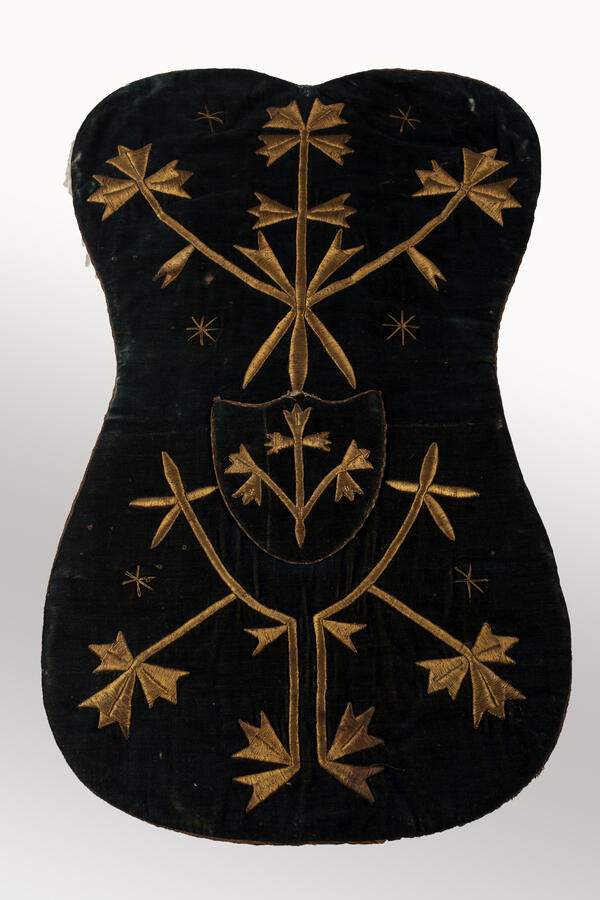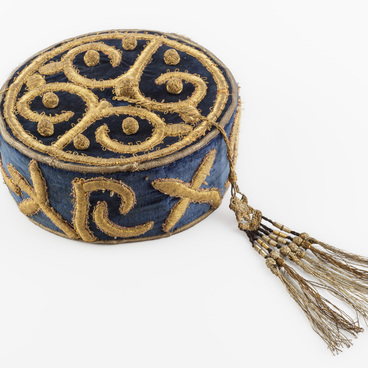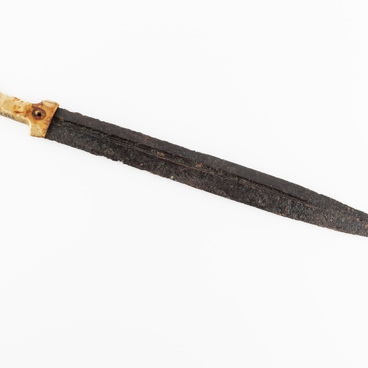According to the experts, pocket watches appeared in the 17th century with the invention of a small clock mechanism that could be put inside a pocket. Men usually wore watches in a special pocket (called fob) on a watch chain with a small decoration. Women wore watches on their wrists as elegant bracelets adorned with precious stones, or around their necks as small necklaces.
In the Caucasus, pocket watches appeared in the 19th century and were a luxury item, a sign of the high social status. Therefore, they were kept very carefully, in a special pouch in the most prominent place in the house. Watch pouches came in different shapes and sizes.
The watch pouch from the museum exhibition was mounted on the wall. It has a guitar shape. This piece was made by a craftswoman from the village of Pchegatlukai in Adygea. To create it, the artisan lined a thick cardboard base with dark green velvet. In the center she sewed a semi-oval pocket, which served as a place to store a pocket watch. The watch pouch is decorated with gold thread embroidery using the “urban sewing” technique. This was the Caucasian term used for satin stitch embroidery, which became popular in the 19th and early 20th centuries, but was considered less lavish than the traditional sewing technique called “v prikrep” (in attachment).
The pattern was embroidered directly on the fabric. Previously, a stencil had been cut out of paper or thin cardboard, sewn onto fabric, embroidered with gold or silver threads, and fixed with silk along the outline of the pattern. Sometimes craftswomen used thin braid to enhance the contours. The satin stitch became more pronounced due to the cardboard stencil or extra padding. Satin stitch embroidery most often decorated small items, and in clothing —women’s hats and false shirtfronts. In the late 19th — early 20th century, a simultaneous combination of the first and second types of sewing could be found on clothes, pouches and fans.
The craftswoman used a floral Circassian pattern as the basis for decorating the watch pouch. Symmetrical stems, which end in two or more petal, form a heart-shaped figure. The pattern was often used to decorate household items, weapons and clothing. All elements of the ornament had a certain meaning and were associated with religious rites.
In the Caucasus, pocket watches appeared in the 19th century and were a luxury item, a sign of the high social status. Therefore, they were kept very carefully, in a special pouch in the most prominent place in the house. Watch pouches came in different shapes and sizes.
The watch pouch from the museum exhibition was mounted on the wall. It has a guitar shape. This piece was made by a craftswoman from the village of Pchegatlukai in Adygea. To create it, the artisan lined a thick cardboard base with dark green velvet. In the center she sewed a semi-oval pocket, which served as a place to store a pocket watch. The watch pouch is decorated with gold thread embroidery using the “urban sewing” technique. This was the Caucasian term used for satin stitch embroidery, which became popular in the 19th and early 20th centuries, but was considered less lavish than the traditional sewing technique called “v prikrep” (in attachment).
The pattern was embroidered directly on the fabric. Previously, a stencil had been cut out of paper or thin cardboard, sewn onto fabric, embroidered with gold or silver threads, and fixed with silk along the outline of the pattern. Sometimes craftswomen used thin braid to enhance the contours. The satin stitch became more pronounced due to the cardboard stencil or extra padding. Satin stitch embroidery most often decorated small items, and in clothing —women’s hats and false shirtfronts. In the late 19th — early 20th century, a simultaneous combination of the first and second types of sewing could be found on clothes, pouches and fans.
The craftswoman used a floral Circassian pattern as the basis for decorating the watch pouch. Symmetrical stems, which end in two or more petal, form a heart-shaped figure. The pattern was often used to decorate household items, weapons and clothing. All elements of the ornament had a certain meaning and were associated with religious rites.



